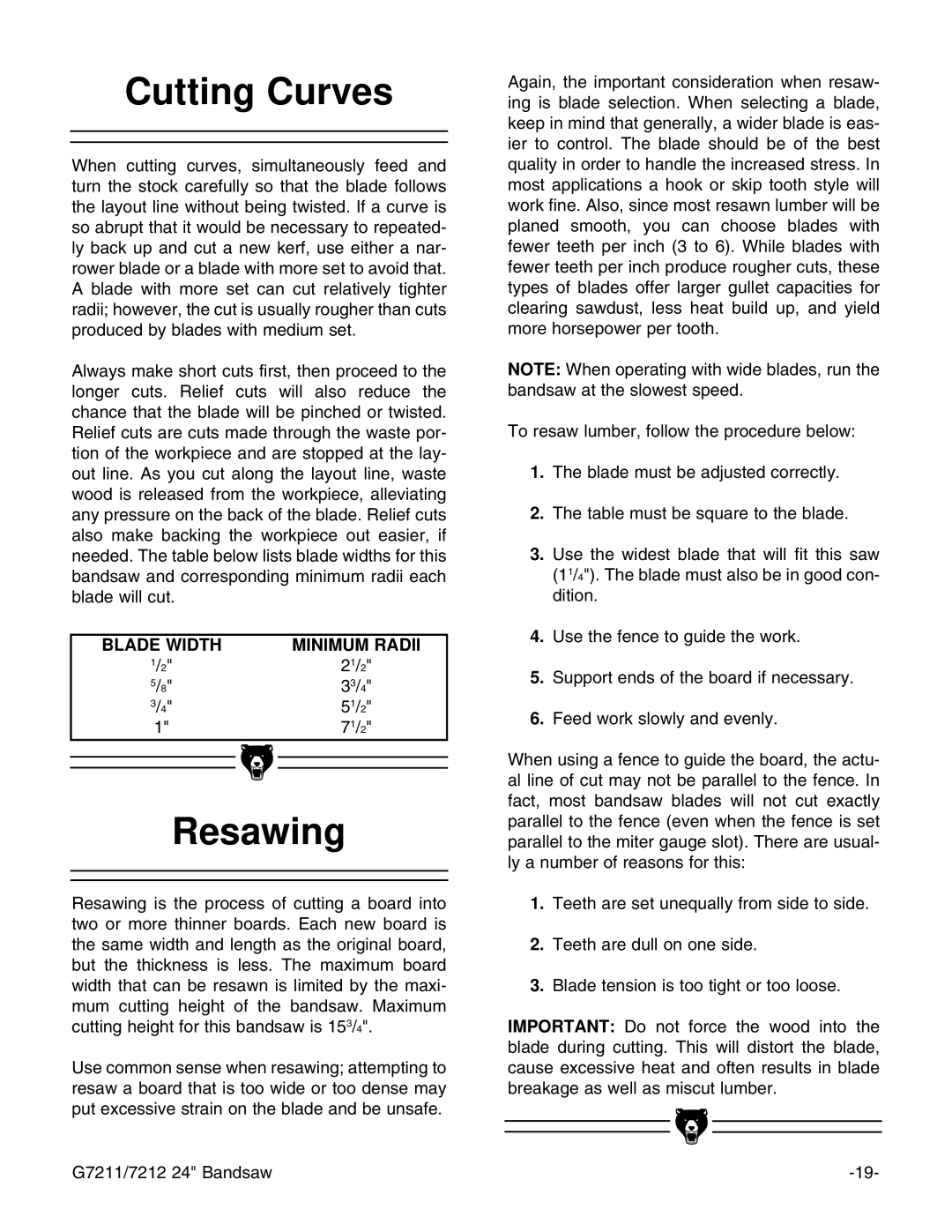
Cutting Curves
When cutting curves, simultaneously feed and turn the stock carefully so that the blade follows the layout line without being twisted. If a curve is so abrupt that it would be necessary to repeated- ly back up and cut a new kerf, use either a nar- rower blade or a blade with more set to avoid that. A blade with more set can cut relatively tighter radii; however, the cut is usually rougher than cuts produced by blades with medium set.
Always make short cuts first, then proceed to the longer cuts. Relief cuts will also reduce the chance that the blade will be pinched or twisted. Relief cuts are cuts made through the waste por- tion of the workpiece and are stopped at the lay- out line. As you cut along the layout line, waste wood is released from the workpiece, alleviating any pressure on the back of the blade. Relief cuts also make backing the workpiece out easier, if needed. The table below lists blade widths for this bandsaw and corresponding minimum radii each blade will cut.
BLADE WIDTH |
| MINIMUM RADII |
1/2" | 21/2" | |
5/8" | 33/4" | |
3/4" | 51/2" | |
1" | 71/2" | |
|
|
|
|
|
|
|
|
|
Resawing
Resawing is the process of cutting a board into two or more thinner boards. Each new board is the same width and length as the original board, but the thickness is less. The maximum board width that can be resawn is limited by the maxi- mum cutting height of the bandsaw. Maximum cutting height for this bandsaw is 153/4".
Use common sense when resawing; attempting to resaw a board that is too wide or too dense may put excessive strain on the blade and be unsafe.
Again, the important consideration when resaw- ing is blade selection. When selecting a blade, keep in mind that generally, a wider blade is eas- ier to control. The blade should be of the best quality in order to handle the increased stress. In most applications a hook or skip tooth style will work fine. Also, since most resawn lumber will be planed smooth, you can choose blades with fewer teeth per inch (3 to 6). While blades with fewer teeth per inch produce rougher cuts, these types of blades offer larger gullet capacities for clearing sawdust, less heat build up, and yield more horsepower per tooth.
NOTE: When operating with wide blades, run the bandsaw at the slowest speed.
To resaw lumber, follow the procedure below:
1.The blade must be adjusted correctly.
2.The table must be square to the blade.
3.Use the widest blade that will fit this saw (11/4"). The blade must also be in good con- dition.
4.Use the fence to guide the work.
5.Support ends of the board if necessary.
6.Feed work slowly and evenly.
When using a fence to guide the board, the actu- al line of cut may not be parallel to the fence. In fact, most bandsaw blades will not cut exactly parallel to the fence (even when the fence is set parallel to the miter gauge slot). There are usual- ly a number of reasons for this:
1.Teeth are set unequally from side to side.
2.Teeth are dull on one side.
3.Blade tension is too tight or too loose.
IMPORTANT: Do not force the wood into the blade during cutting. This will distort the blade, cause excessive heat and often results in blade breakage as well as miscut lumber.
G7211/7212 24" Bandsaw |
